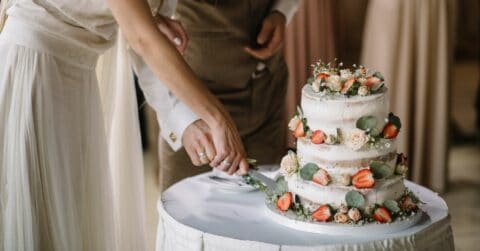Planning Process:
Bilingual weddings have become increasingly popular in recent years as more and more couples want to celebrate their love in a way that reflects both cultures. Planning a bilingual wedding can be a bit more complex than a traditional one, but it can be an extraordinary and memorable event with the right approach.
Setting the date, budgeting, and finding a venue:
The first step in planning a bilingual wedding is to set the date. Choosing a date that works for both families and makes sense for the cultures you are celebrating is essential. Once you have a date in mind, it’s time to start thinking about the budget. Bilingual weddings can be expensive, so it’s critical to plan carefully and ensure you have enough money to cover your costs. Finally, you will need to find a venue accommodating both cultures and languages.
Having bilingual officiants:
One of the essential elements of a bilingual wedding is having bilingual officiants. Whether you choose to have a Chinese or English-speaking priest, rabbi, or justice of the peace, it’s essential to ensure they are fluent in both languages. This will allow both families to understand the ceremony and participate fully in the celebration. When searching for a bilingual officiant, consider reaching out to local churches or synagogues or looking online for experienced wedding planners.
Ceremony Elements:
Exploring cultural traditions specific to Chinese and English weddings
There are many cultural traditions specific to Chinese and English weddings, and it’s essential to understand them so you can decide which ones you want to incorporate into your ceremony. For example, in traditional Chinese weddings, the bride and groom exchange rings, while in English weddings, they also exchange vows. It’s also important to consider food, attire, and other cultural elements, such as the use of red and gold in Chinese weddings or the wearing a white dress in English weddings.
Creating a bilingual ceremony program:
One of the critical elements of a bilingual wedding is creating a ceremony program that accurately reflects both cultures. This means finding a way to translate essential elements, such as the vows, into both languages. You can also include cultural symbols and images representing each culture, such as the dragon and phoenix in Chinese weddings or the horseshoe in English weddings.
Crafting bilingual speeches for the ceremony:
In a bilingual wedding, speeches are a powerful way to connect with both sides of the family and friends. Whether you’re the bride, groom, or wedding party member, it’s essential to craft bilingual speeches that accurately reflect your feelings and thoughts and are meaningful to both cultures. To ensure your speeches are well-received, consider working with a professional translator or linguist to translate the message correctly.
Reception Details:
Finding bilingual reception entertainment options:
Entertainment is critical to any wedding reception, and finding bilingual options is crucial. You want everyone to be able to enjoy the music, regardless of the language they speak. One option is to hire a DJ or band to play a mix of songs in both English and Chinese. Another option is to book a bilingual MC, who can keep the party going with announcements, games, and music in both languages.
Preparing bilingual invitations and menu cards:
It’s essential to ensure the information is clear and easy to understand for everyone attending your reception. Your reception invitations and menu cards should also reflect the bilingual nature of your wedding. You can opt for dual-language invitations, menu cards, or separate cards for each language. This is an opportunity to showcase both cultures and ensure everyone is included.
Ensuring both languages are featured prominently in all printed materials, from save-the-date cards to thank-you notes:
From save-the-date cards to thank-you notes, all your printed materials should reflect the bilingual nature of your wedding. This will help set the tone for the entire event and ensure that both languages are given equal prominence. Whether you opt for dual-language materials or different materials in each language, it’s essential to have a consistent design and theme.
Fashion:
Shopping for two sets of bridal outfits in both cultures
The wedding fashion is an essential aspect of any celebration, and shopping for two sets of bridal companies in Chinese style and American style can be challenging. To make it easier, it’s essential to keep a few things in mind:
Consider the cultural significance of each outfit. Chinese wedding dresses are more traditional and elaborate, whereas American wedding dresses are typically more understated.
Think about the overall style and theme of the wedding, as this will impact the type of dress that you choose.
Consider the venue and the time of day the wedding will take place, as this will affect the formality of the dress.
Ultimately, the key is to find outfits that are both stylish and appropriate for the occasion.
Deciding on groomsmen’s ensembles and accessories
When deciding on groomsmen’s ensembles and accessories for a bilingual wedding, it is essential to consider cultural traditions and personal styles. For a Chinese wedding, the groom and groomsmen often wear traditional Chinese attire, such as a Mandarin collar suit or a classic tuxedo with a Chinese-style jacket. For an English wedding, the groomsmen typically wear formal black suits with ties or bow ties to match the bride and groom’s attire.
When choosing accessories, consider incorporating Chinese and English elements, such as wearing red and gold tie pins or cufflinks for a touch of Chinese tradition or incorporating a monogram in both English and Chinese characters. It’s also essential to take into account the theme of the wedding, such as incorporating floral motifs or other elements from the décor into the groomsmen’s accessories.
Ultimately, the most important thing is to ensure that the groomsmen feel comfortable and confident in their attire and that it reflects the style and culture of the couple’s wedding celebration.
Make Your Wedding More Inclusive:
Incorporating cultural elements into the décor and theme of the wedding celebration
Wedding planning can be a stressful experience, but incorporating cultural elements into the décor and theme of the wedding can help to create a memorable and inclusive experience for both the bride and groom and their guests.
Incorporating Chinese and English cultures elements into your wedding décor can be as simple as incorporating traditional flowers, colors, and symbols into the centerpieces, favors, and other decorations. You can also incorporate elements of both cultures into your menu, mixing traditional Chinese and English dishes, such as dim sum and roast beef.
The bride and groom can also include cultural elements in their bridal outfits, such as incorporating traditional Chinese red into their gowns and suits or a conventional English top hat and tails for the groom.
By incorporating cultural elements into your wedding, you will create a memorable and inclusive experience that celebrates the love and connection between the two cultures.
After the Wedding:
Writing thank you notes in both languages
After your bilingual wedding celebration, you must express your gratitude to your guests by writing thank you notes. To ensure everyone feels appreciated, consider writing thank you notes in Chinese and English. This shows your guests that you value their presence on your special day, regardless of their language preference.
You can write personalized notes to each guest or create a standard message in both languages that you can mass produce. It’s essential to make sure each letter is heartfelt and expresses your gratitude in a way that’s meaningful to each individual.
Incorporating both languages into your thank-you notes shows your guests that you care and adds a special touch to a meaningful moment. This thoughtful gesture will be appreciated by your guests and will help them remember your special day for years to come.
Incorporating cultural elements into post-wedding festivities
Post-wedding festivities such as the reception, after-party, or farewell brunch are an excellent opportunity to continue incorporating Chinese and English cultural elements. Consider adding traditional foods, music, games, and customs to the celebration. You can also have bilingual signage and speeches, like during the ceremony, to keep everyone engaged and informed. This creates a cohesive and inclusive atmosphere and allows guests to experience and appreciate the rich traditions of both cultures.
In conclusion, a bilingual wedding can be a beautiful way to celebrate two cultures and bring families together. However, it also requires careful planning and consideration to ensure that both sides feel included and valued. Whether you’re looking to incorporate bilingual elements into your ceremony or reception, or are planning a fully bilingual wedding, there are many resources available to help you make it a success. Remember, the most important thing is to prioritize communication and respect between both families. And if you’re looking for more tips and guidance on planning a bilingual wedding, be sure to check out Vivian’s website at https://mcvivian.com/. As a New York State Ordained Wedding Officiant and Wedding MC with over 9+ years of experience, I have the expertise and dedication to make your special day unforgettable.



